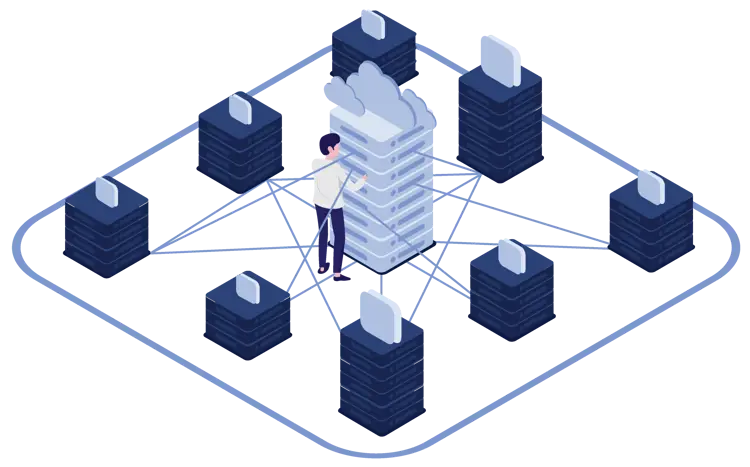Reduce complexity in the Publishing IT stack


Going headless is without a doubt a top trend for publishing companies. And for good reason. Separating the data sources from the presentation layer provides developers with great freedom to create new web experiences.
But opting for headless is not all roses …
Get out of IT lock-in. Fast!
When tens or even hundreds of brand and publication sites across the whole media company are fed data by a handful or more CMSs and back-office systems, the architecture cannot help but become severely complex.
Even with a headless CMS infrastructure, there are still dozens of source systems behind the CMS – each with its own custom integration to maintain.
And this is where the party stops, and the hard work begins.
Because moving to headless, you often end up with a spiderweb of integrations, orchestrated by a few central in-house developers who are already completely swamped.
Essentially you risk finding yourself in a tech lock-in. Basically, your legacy tech stack locks you in when upgrades and maintenance become increasingly complex the more integrations are hooked in.
Technological debt of headless
Publishers typically have multiple sources feeding data to the many frontends: One or more CMSs, Digital Asset Management systems, wire feeds, archives, ERP, search, subscription systems, and personalisation providers. And we could probably keep going.
All sites and mobile apps are deeply dependent on several scripts and APIs to exchange content and ready it for distribution on various platforms and syndication channels.
The many (many, many) integrations between your data sources can end up challenging the flexibility that was the reason you chose to go headless in the first place – and you’re left vulnerable to team changes in a highly competitive labour market where developers are hard to find.
Don’t sacrifice your performance
Speed matters. So dust off that pedal.
Performance is typically one of the first to suffer as sites are dependent on several internal systems serving individual parts of an article. If the page is generated and data fetched from source systems on request time, load time can get painfully slow, and no matter how many caching layers or varnish you add, your SEO score is impaired – because Google rewards faster loading sites, and yours may be bumped down on the list.
Out-of-the-box Speed Layer
Enterspeed is a SaaS created to simplify, speed up, and de-risk a complex IT landscape – also for publishers like you.
You can call us an “out-of-the-box Speed Layer”. Enterspeed comes prebuilt with a low-code editor to let source systems push data through a super-fast storage and into a single API endpoint.
Low-code data transformation schemas make sure content data is uniform and prepared for delivery to whatever reader experience your developers may build. And as with any serious cloud service, your content is secure by design and ready for global delivery within milliseconds.
📹Check out our 100 sec. intro to Enterspeed in publishing in the video below 📹
The solution to getting out of the lock-in is surprisingly straightforward and based on 4 key pillars which can be implemented gradually 👇
1️⃣ Establish a decoupled Speed Layer
You can build one yourself or you can sign up to Enterspeed and get started in hours, not weeks or months. (Yes, seriously, hours 🕺🏼). It’s built on MS Azure, and global distribution and security are built-in by design.
2️⃣ Ingest data from CMS and multiple source systems using low-code APIs
We have done most of the work already by preparing High Performing APIs for e.g. Umbraco, WordPress and Sitecore. Getting data replicated to the Enterspeed cloud storage is done with just a few lines of code.
3️⃣ Connect your front ends to Enterspeed's Speed Layer
With all data consolidated and readily available in Enterspeed, you now have a response time of approx. 50 milliseconds and a global delivery already in place. Using our low-code schema editor, data is transformed/merged above the source systems, to keep back-office systems as close to standard as possible.
4️⃣ Set your source systems free, one by one
Choose evolution over revolution. With all data needed by the front end served out of Enterspeed, you can take risk and complexity out of your infrastructure by connecting more systems (e.g. DAM, PIM, ERP, etc.) directly to Enterspeed and cleaning up old custom horizontal integrations between sources.
Time to reap the benefits of a Speed Layer 🎯
✔️ Get current by upgrading CMS and back-office systems to the latest releases (remember, data is served out of Enterspeed independent of source systems, so you can take other systems offline for upgrade without worry).
✔️ Focus on new initiatives and better end-user experiences instead of wearing down developers putting out fires when legacy systems and complex integrations fail.
✔️ And finally, watch your Google score (and of course, your reader experience) improve as your sites are generated faster!

Thrown into tech marketing and loving it. Mother of two, wife of one, runner, and reader of romance.
